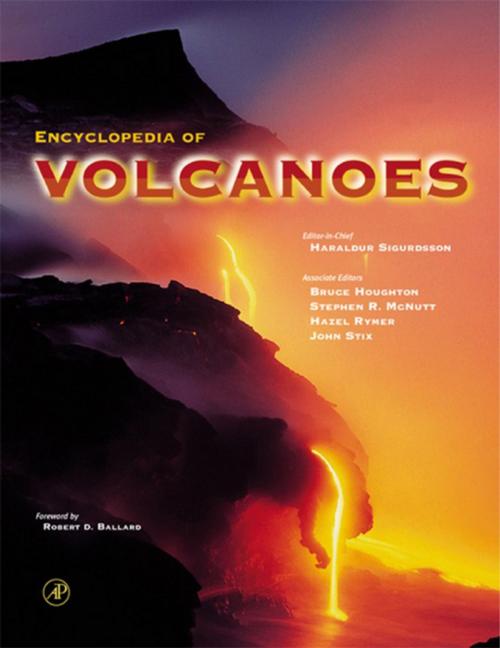| Author: | Haraldur Sigurdsson, Bruce Houghton, Hazel Rymer, John Stix, Steve McNutt | ISBN: | 9780080547985 |
| Publisher: | Elsevier Science | Publication: | October 23, 1999 |
| Imprint: | Academic Press | Language: | English |
| Author: | Haraldur Sigurdsson, Bruce Houghton, Hazel Rymer, John Stix, Steve McNutt |
| ISBN: | 9780080547985 |
| Publisher: | Elsevier Science |
| Publication: | October 23, 1999 |
| Imprint: | Academic Press |
| Language: | English |
Volcanoes are unquestionably one of the most spectacular and awe-inspiring features of the physical world. Our paradoxical fascination with them stems from their majestic beauty and powerful, if sometimes deadly, destructiveness.
Notwithstanding the tremendous advances in volcanology since ancient times, some of the mystery surrounding volcanic eruptions remains today. The Encyclopedia of Volcanoes summarizes our present knowledge of volcanoes. Through its thematic organization around the melting of the earth, it provides a comprehensive source of information on the multidisciplinary influences of volcanic eruptions--both the destructive as well as the beneficial aspects.
The majority of the chapters focus on the geoscience-related aspects of volcanism (radioactive heat source, melting rock, ascent of magma, surface phenomena associated with exiting magma, extraterrestrial volcanism, etc.). In addition, complementary chapters discuss the multidisciplinary aspects of volcanism; these include the history of volcanology, geothermal energy resources, interaction with the oceans and atmosphere, health aspects of volcanism, mitigation of volcanic disasters, post-eruption ecology, and the impact of eruptions on organismal biodiversity.
In addition to its appeal to educators, students, and professional and amateur scientists, the Encyclopedia of Volcanoes functions as an important information resource for administrators and officials responsible for developing and implementing volcanic hazard mitigation around the world.
* The first and only reference work to cover all aspects of volcanology
* More than 80 separate peer-reviewed articles--all original contributions by leading authors from major institutions of science around the world, commissioned for this work
* An integrated transition from the volcanic process through hazards, risk, and societal impacts, with an emphasis on how volcanoes have influenced and shaped society
* Convenient single-volume format with topics arranged thematically--articles provide coverage of nine different aspects of volcanology
* Each entry in the Encyclopedia begins with an outline of the article content and a concise definition of the subject of the article
* 3,000 Glossary entries explain key terms
* Further Reading lists appear at the end of each entry
* Extensive cross-referencing system links related articles
* Sixteen pages of color will convey the science and excitement of this often violent phenomena
* Large 8 1/2" x 11" page size, easy-to-read double-column format
Volcanoes are unquestionably one of the most spectacular and awe-inspiring features of the physical world. Our paradoxical fascination with them stems from their majestic beauty and powerful, if sometimes deadly, destructiveness.
Notwithstanding the tremendous advances in volcanology since ancient times, some of the mystery surrounding volcanic eruptions remains today. The Encyclopedia of Volcanoes summarizes our present knowledge of volcanoes. Through its thematic organization around the melting of the earth, it provides a comprehensive source of information on the multidisciplinary influences of volcanic eruptions--both the destructive as well as the beneficial aspects.
The majority of the chapters focus on the geoscience-related aspects of volcanism (radioactive heat source, melting rock, ascent of magma, surface phenomena associated with exiting magma, extraterrestrial volcanism, etc.). In addition, complementary chapters discuss the multidisciplinary aspects of volcanism; these include the history of volcanology, geothermal energy resources, interaction with the oceans and atmosphere, health aspects of volcanism, mitigation of volcanic disasters, post-eruption ecology, and the impact of eruptions on organismal biodiversity.
In addition to its appeal to educators, students, and professional and amateur scientists, the Encyclopedia of Volcanoes functions as an important information resource for administrators and officials responsible for developing and implementing volcanic hazard mitigation around the world.
* The first and only reference work to cover all aspects of volcanology
* More than 80 separate peer-reviewed articles--all original contributions by leading authors from major institutions of science around the world, commissioned for this work
* An integrated transition from the volcanic process through hazards, risk, and societal impacts, with an emphasis on how volcanoes have influenced and shaped society
* Convenient single-volume format with topics arranged thematically--articles provide coverage of nine different aspects of volcanology
* Each entry in the Encyclopedia begins with an outline of the article content and a concise definition of the subject of the article
* 3,000 Glossary entries explain key terms
* Further Reading lists appear at the end of each entry
* Extensive cross-referencing system links related articles
* Sixteen pages of color will convey the science and excitement of this often violent phenomena
* Large 8 1/2" x 11" page size, easy-to-read double-column format















